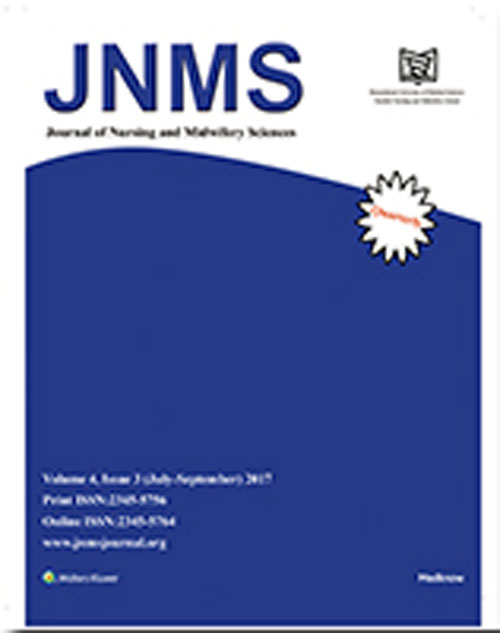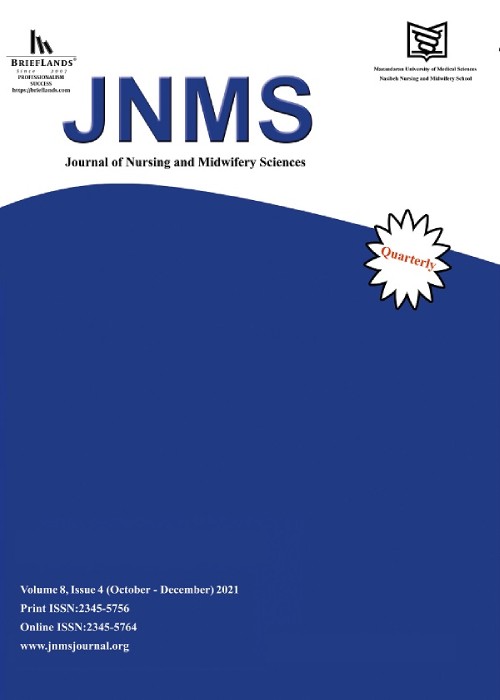فهرست مطالب

Journal of Nursing and Midwifery Sciences
Volume:4 Issue: 3, Jul-Sep 2017
- تاریخ انتشار: 1396/06/31
- تعداد عناوین: 7
-
-
Page 69Context: MS is a chronic and debilitating disease, in which the immune reactions damage myelin sheath of axons in the central nervous system. Psychological consequences of MS and the treatment have been the subject of many research activities
Aims: The present study examines the effectiveness of acceptance and commitment therapy (ACT) based on the life expectancy in patients with multiple sclerosis (MS). Setting and Design: This study was a randomized clinical trial and conducted from September 2016 to May 2017 in the MS patients of North Khorasan Province and Shirvan city in 2016.
Methods and Material: This is an applied and quasi experimental research with pretest, posttest, and control group. Using the available sampling method, 30 samples were selected by random assignment and included in experimental and control groups (15 people per group). The instrument used in this study was Schneider's life expectancy questionnaire. The experimental group received eight sessions of therapeutic intervention. Statistical Analysis Used: We used mean and standard deviation, regression line, analyze covariance to analysis of data.ResultsThe results of covariance analysis showed that ACT significantly improves life expectancy in patients with MS.ConclusionsAccording to the results, it is expected that ACT maintains its effects in the long run with features such as encouraging people to live in the present moment, mindfulness, commitment to the pursuit of worthwhile goals, and an emphasis on process rather than the outcome.Keywords: Acceptance, commitment therapy, Life expectancy, Multiple sclerosis -
Page 75Context: Chemotherapy induced nausea vomiting and fatigue are prevalent problems following chemotherapy and pharmacologic methods are moderately efficient in alleviating them. Acupressure is a substitute approach.
Aims: This paper sought to determine the effectiveness of acupressure application in relieving nausea vomiting and fatigue among children with acute lymphoblastic leukemia in compression with a placebo treatment. Settings and Design: In this single blind, randomized, placebo controlled clinical trial, 120 hospitalized school age children with ALL, randomly divided into experimental and placebo groups. Subjects rated the intensity of nausea and fatigue by visual analog scales.
Material andMethodsIn the experimental group, finger acupressure on p6 and ST36 (true points) and in the placebo group on SI3 and LI12 (sham points) was applied. Symptoms of nausea and fatigue intensity immediately and an hour postintervention evaluated. Then variable of nausea vomiting and Fatigue was also measured 12 h postintervention by the instruments of Adapted Rhodes Index of Nausea and Vomiting for Pediatrics by Child and Fatigue Scale Child, Respectively. Statistical Analysis Used: Data were analyzed by SPSS version 16.0.ResultsSignificant differences were observed between two groups based on the fatigue and nausea intensity immediately and an hour postintervention with confidence interval 95% and PConclusionsApplying one time acupressure may reduce the intensity of nausea immediately postintervention and fatigue and nausea at one hour post treatment. Hence, acupressure could be recommended as a helpful, nonpharmacologic method for some cancer related fatigue and chemotherapy induced nausea vomiting management.Keywords: Acupressure, Acute lymphoblastic leukemia, Chemotherapy, Fatigue, Nausea-vomiting -
Page 82Context: Brain injury can cause coma and organized auditory stimulation (OAS) is thought to be associated with improvements in the level of consciousness.
Aims: Determine of the effect of OAS on levels of consciousness in comatose patients with head injury Setting and Design: This study was a randomized clinical trial and conducted from July 2012 to February 2013 in the Panje Azar Hospital of Gorgan, Iran.Materials And MethodsThe patients from critical care units were enrolled and randomly allocated into two groups, each group 20 patients. The intervention group underwent OAS using a nurse's voice who tried to call the patient's attention to their place, time, identification, family, and profession. This stimulation was conducted thrice daily for 10 days, and patient consciousness was measured by the Glasgow Coma Scale (GCS). Statistical Analysis Used: We used mean and standard deviation, Chi square, t test, and repeated measures to analysis of data.ResultsThe level of consciousness increased in both intervention and control groups, but the increase in the intervention group was more than the control group (PConclusionThe level of consciousness of patients improved following an organized OAS by the nurses. Therefore, OAS likely will be a useful and applicable intervention for patients in Intensive Care Units.Keywords: Auditory stimulation, Coma, Consciousness level, Head injury -
Page 89Context: Children's pain in hospital settings has not yet been managed well. Although nurses play an important role in pain management, its extent is limited with respect to clinical nurses in Iran.
Aims: This study was conducted to explore the experience of nurse's barriers to pain management in pediatric units. Settings and Design: This qualitative study was conducted at two teaching hospitals in Amirkola Children's Hospital in Babol and Children's Medical Centers in Tehran, Iran. Data were collected from 19 nurses, using unstructured and deep interviews during 20142015.
Material andMethodsSampling was purposeful with maximum variation. Data analyzed by conventional content analysis method simultaneously data collection based on five steps of Granheim and Lundman (2004). To ensure about the accuracy and reliability of data, four criteria namely credibility, confirmability, dependability, and transferability, were used according to Lincoln and Guba's criteria. Before the interviews, participants were ensured about the confidentiality of their information and voluntarily nature of the study. In addition, written informed consents of the nurses were obtained.ResultsData analysis extracted five themes of barriers to pain management, including: Inappropriate organizational structure, interruption in pain relief activities, inadequate competency of the nurses, individual characteristics of child and parents, and inefficacy of companions. These themes indicated the barriers to pediatric pain management based on research conditions and experience of nurses in the pediatric ward.ConclusionsTherefore, modification of organizational structure, elimination of causes of delay in pain relief measures, promotion of nursing competencies, paying attention to child and parent's characteristics, and improvement of companion's effectiveness should be prioritized to achieve an optimal pain managementKeywords: Nurses, Pain management, Pediatric, Qualitative research -
Page 97Context: Nursing process is the systematic method of thinking used by nurses to develop an individualized plan of care for patients. Effective use of the nursing process depends on a nurse's familiarity with the standardized nursing language.
Aim: This study evaluates the utilization of nursing process on the day of admission and within 24 h of patient admission in a teaching hospital. Setting and Design: Descriptive and Retrospective design was utilized.Materials And MethodsSystematic sampling technique was adopted to evaluate 959 patient's records from 2014 to 2016 in 2 medical and 2 surgical wards over 3 months period using a self designed checklist. Statistical Analysis Used: Data collected was analyzed using SPSS version 21 and presented as frequencies and percentages. T test was used to test the significant difference between variables with P value set at ≤ 0.05.ResultsOnly 24.9% of the medical records contained the nursing process form. On the day of admission,ConclusionsNursing process utilization remained poorly incorporated into the activities of nurses in this institution. Therefore, continuing professional education on nursing process and supervision should be mandated.Keywords: Nursing assessment, Nursing diagnosis, Nursing process utilization -
Page 104Context: Despite the emphasis on the preconception care, the majority of people are not aware of how environmental and lifestyle factors influence reproductive and fetal health.
Aims: The objective of this study was to determine knowledge and attitude of women in reproductive age about preconception health in the context of free and universal access to preconception health care. Setting and Design: A cross-sectional study in public health centers.Materials And MethodsThis study was performed using a convenient sample of 400 women presenting to public health centers in Abhar, Iran. Knowledge and attitude were assessed using researcher-made questionnaire. Questionnaire went through validity and reliability process. Statistical Analysis Used: Data were analyzed using SPSS version 19. The knowledge and attitude scores among subgroups according to demographic characteristics were studied using ANOVA test.ResultsOver two third (68.8%) of women had adequate knowledge about preconception care. Sixty nine percent had positive attitude towards preconception care. Education and age were significantly associated with knowledge and attitude.ConclusionDespite the relatively high level of knowledge, nearly half of the women perceived preconception health optimization as difficult that may lead to not engaging in preconception health behaviors. The younger women and those with fewer years of education should be focus of preconception health program.Keywords: Attitude, Iran, Knowledge, Preconception care, Primary health care -
Page 110Child abuse is one of the most challenging social problems worldwide. Failure to report child abuse may lead to the aggravation of the situation and increase the probability of further abuses. This study aimed to determine the challenges of child abuse reports by healthcare professionals. This narrative review study was conducted through searching the databases such as Google Scholar, PubMed, Web of Science, Scopus, and ProQuest. The inclusion criterion was studies in Persian and English languages which published in scientific journals between 1978 and 2017 and also refer to reporting child maltreatment. Studies which, despite referring to a child abuse, did not refer to the barriers to the reporting of child abuse were discarded from further analysis. 56 papers were used to write the present paper. The results of this study organized into four categories: individual barriers (knowledge of healthcare professionals, their attitudes and beliefs, their inadequate experiences, and uncertainty of the diagnosis), interpersonal barriers (fear of disconnecting therapeutic relationships and violation of privacy and secrecy principles), organizational barriers (poor communication and weak legal processes for reporting), and situational barriers (victim's characteristics and available evidence). Given the reporting of child abuse by healthcare professionals is affected by multiple factors such as individual, interpersonal, organizational, and situational factors, so considering a comprehensive and collaborative program for this public problem in all levels is important.Keywords: Child abuse, Child maltreatment, Child mistreatment, Healthcare professionals, Narrative review


